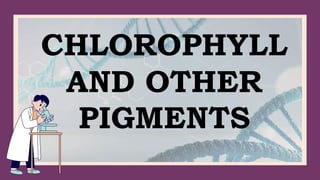
5. CHLOROPHYLL.pptx
- 3. BACKGROUND INFORMATION Photosynthesis is the process used by plants, algae and certain bacteria to harness energy from sunlight and turn it into chemical energy. Most living things depend on photosynthetic cells to manufacture the complex organic molecules they require as a source of energy. Photosynthetic cells are quite diverse and include cells found in green plants, phytoplankton, and cyanobacteria.
- 4. BACKGROUND INFORMATION During the process of photosynthesis, cells use carbon dioxide and energy from the Sun to make sugar molecules and oxygen. These sugar molecules are the basis for more complex molecules made by the photosynthetic cell, such as glucose. Then, via respiration processes, cells use oxygen and glucose to synthesize energy-rich carrier molecules, such as ATP, and carbon dioxide is produced as a waste product. Therefore, the synthesis of glucose and its breakdown by cells are opposing processes.
- 5. Photosynthesis takes place in two sequential stages: 1. The light-dependent reactions; 2. The light-independent reactions, or Calvin Cycle.
- 6. LIGHT-DEPENDENT REACTIONS Just as the name implies, light- dependent reactions require sunlight. In the light-dependent reactions, energy from sunlight is absorbed by chlorophyll and converted into stored chemical energy,
- 7. LIGHT-DEPENDENT REACTIONS in the form of the electron carrier molecule NADPH (nicotinamide adenine dinucleotide phosphate) and the energy currency molecule ATP (adenosine triphosphate). The light-dependent reactions take place in the thylakoid membranes in the granum (stack of thylakoids), within the chloroplast.
- 9. Figure: The two stages of photosynthesis: Photosynthesis takes place in two stages: light- dependent reactions and the Calvin cycle (light-independent reactions). Light-dependent reactions, which take place in the thylakoid membrane, use light energy to make ATP and NADPH. The Calvin cycle, which takes place in the stroma, uses energy derived from these compounds to make GA3P from CO2.
- 10. Photosystems are the functional units for photosynthesis, defined by a particular pigment organization and association patterns, whose work is the absorption and transfer of light energy, which implies transfer of electrons. Physically, photosystems are found in the thylakoid membranes. PHOTOSYSTEMS
- 12. In the light-independent reactions or Calvin cycle, the energized electrons from the light-dependent reactions provide the energy to form carbohydrates from carbon dioxide molecules. The light- independent reactions are sometimes called the Calvin cycle because of the cyclical nature of the process. Although the light-independent reactions do not use light as a reactant (and as a result can take place at day or night), they require the products of the light dependent reactions to function. LIGHT DEPENDENT REACTION
- 13. The light-independent molecules depend on the energy carrier molecules, ATP and NADPH, to drive the construction of new carbohydrate molecules. After the energy is transferred, the energy carrier molecules return to the light-dependent reactions to obtain more energized electrons. In addition, several enzymes of the light-independent reactions are activated by light.
- 14. Chlorophyll is a green photosynthetic pigment found in plants, algae, and cyanobacteria. Chlorophyll absorbs mostly in the blue and to a lesser extent red portions of the electromagnetic spectrum, hence its intense green color. Green substance in producers that traps light energy from the sun, which is then used to combine carbon dioxide and water into sugars in the process of photosynthesis Chlorophyll is vital for photosynthesis, which helps plants get energy from light. CHLOROPHYLL
- 15. Chlorophyll molecules are specifically arranged in and around pigment protein complexes called photosystems, which are embedded in the thylakoid membranes of chloroplasts. CHLOROPHYLL
- 16. There are four types of chlorophyll: chlorophyll a, found in all higher plants, algae and cyanobacteria; chlorophyll b, found in higher plants and green algae; chlorophyll c, found in diatoms, dinoflagellates and brown algae; and chlorophyll d, found only in red algae. In plants, chlorophyll a and chlorophyll b have prominent absorption roles as pigments. Chlorophyll a and b differ in structure and function. In photosynthesis, chlorophyll a plays a more important role ,as it is the one that directly absorbs light energy. CHLOROPHYLL PIGMENTS
- 17. In contrast , chlorophyll b is considered an accessory pigment because it transfers only the absorbed light energy to chlorophyll a. You see chlorophyll as green because this is the only color that most plants do not absorb. Both chlorophyll a and b absorb violet, blue, and red lights, and they reflect the green light back to our eyes CHLOROPHYLL PIGMENTS
- 18. Carotenoid, another common pigment, also plays an accessory role. It is in the shade of yellow and orange because again, these colors are the ones that are reflected back to our eyes. It absorbs only the violet – blue-green range. During autumn in most temperate regions, carotenoid pigments become apparent in trees because their chlorophyll breaks down. CHLOROPHYLL PIGMENTS
- 20. What Cells and Organelles Are Involved in Photosynthesis? Photosynthetic cells contain special pigments that absorb light energy. Different pigments respond to different wavelengths of visible light. Chlorophyll, the primary pigment used in photosynthesis, reflects green light and absorbs red and blue light most strongly.
- 21. In plants, photosynthesis takes place in chloroplasts, which contain the chlorophyll. Chloroplasts are surrounded by a double membrane and contain a third inner membrane, called the thylakoid membrane that forms long folds within the organelle. The green pigment chlorophyll is located within the thylakoid membrane, and the space between the thylakoid and the chloroplast membranes is called the stroma .
- 22. Chlorophyll A is the major pigment used in photosynthesis, but there are several types of chlorophyll and numerous other pigments that respond to light, including red, brown, and blue pigments. These other pigments may help channel light energy to chlorophyll A or protect the cell from photo-damage.
- 23. For example, the photosynthetic protists called dinoflagellates, which are responsible for the "red tides" that often prompt warnings against eating shellfish, contain a variety of light sensitive pigments, including both chlorophyll and the red pigments responsible for their dramatic coloration.